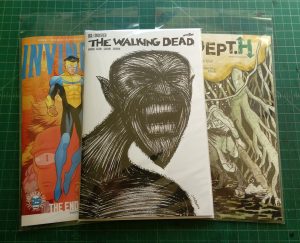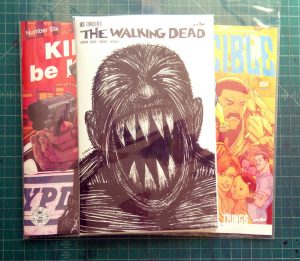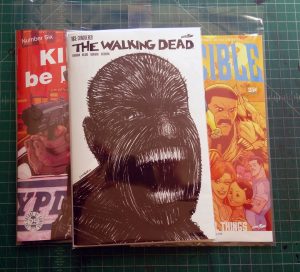
One of the things that’s popped up in recent years in the word of comic book collecting is blank covers. They’re published that way on purpose so that a comic book collector can go to a comic con and get his or her favorite artist to do a sketch on the blank cover. It’s a cool idea. A drawing right on a comic. A lot of comic book collectors have embraced the concept. Some artists even buy the blanks themselves, draw on them, and then sell them to collectors.
I’ve even bought some blanks myself, drawn on them, and tried to sell them on eBay. Not much luck there but that’s the life of being a nobody. One of the problems I’ve had drawing on the blank covers is the expense. With comics generally costing four dollars a piece these days that makes for an expensive single piece of paper. It wouldn’t matter if I was making up that cost in sales but I’m not. So I had to find a cheaper way to do things.
When I was a kid I was a do-it-yourself tinkerer. I liked to try and fix things. So when I got my hands on some battered old comics I did my best to repair them. That sort of restoration is frowned upon now in the world of collectors but that really only applies to high dollar books. No one would care one bit if I tried to fix some random comic that had a street value of fifty cents. Fixing comics in my youth is how I learned to reattach a cover or centerfold of a comic that had come loose from its staples.

The first thing you have to do when fixing a cover is to unbend and remove the staples. You’re going to need some needle nose pliers for this. After the staples are removed I recommend straightening them. This makes it easier to put them back in the holes they came from. Then cut a tiny bit of tape with an X-Acto knife, these days I use acid free framer’s tape, and place the tape on the inside of the spine of the comic (or the centerfold) where the staples holes that have been torn through are. Poke new holes in the tape where the staple holes are. After that put the cover (or centerfold) back on the book and thread the staples, one wire at a time, back through the holes they came out of. Finally bend the staples back down to secure them. It’s an obvious method but I was happy to have figure it out back when I was eleven.
That brings us up to now and my desire for some cheap comics to draw on the cover of. I had thought about pulling some old comics out of the dollar bin at my local comic store or even from my own collection. I have worthless comics I could easily get rid of. But somehow that didn’t appeal to me. It seemed weirdly random and didn’t interest me. I sat on the idea for a while and did nothing with it. Then they released a 25¢ issue of “The Walking Dead.”
The the 25th Anniversary of the founding of Image Comics. To promote that fact they are publishing some of their comics at a cost of only a quarter. The first one of them was issue 163 of “The Walking Dead” which is a comic that is on my pull list. When reading the issue I came to the letter’s page where they wrote that they printed up a whole lot of issue 163. 750,000 of them. I believe the normal circulation of “The Walking Dead” is around 120,000 so that is a big multiple of normal. I figure they could spare a few copies to not be in mint condition. Somehow it made me feel better knowing I was going to deface a comic that had zero chance of ever being valuable.
The week after the issues came out I was at my local comic shop again and I decided to pick up ten copies of WD 163. At $2.50 it was a fraction of the $30.00 it would have cost me to get issue 162 (“The Walking Dead” is one of the cheaper comics with a cover price of $3). I told my LCS owner what I was up to and he gave me the comics on the house. Turns out he had a lot of extra ones. As with so many comics these days there were incentive covers that came with ordering extra WD 163s. If a comic shop ordered a hundred copies they got one with a special cover that they could sell for $50. At 200 copies an extra cover that they might be able to sell for even more. That’s how my LCS owner ended up with about 500 extra copies.

With those extra copies at home I had to make a template for the cover. If I was going to wrap the comic with my own drawing paper I had to be able to but it to the exact size I needed first. This is remarkably tricky. You’d think it would be as easy as measuring the size of the comic but it take a little more than that. After three or four tries I finally had the right size and it was time to get to work.
At first I wasn’t sure if I was going attach the drawing paper first and then draw on it or draw on the sheet of Bristol and then attach it. Since I already had a test one done and attached I decided that one could wait and I’d try drawing on the unattached paper. I thought that way would be simpler in the long run if I could easily attach it. Turns out I could.
I completed my drawing, cut it to size, folded it in half (with guidelines printed out on the paper to make it foolproof), removed the staples from the comic, marked where the staple holes needed to be made, made the holes in the Bristol with an X-Acto knife, and finally put the staples back in place. That whole process took me about fifteen minutes. Not bad but I’ve since got it down to ten.
So far I’ve made four WD 163 sketch covers. I’m playing around with various approaches to them and none have sold yet but I’m still trudging on for a little while. Life is all about the trudging on.
Discussion ¬